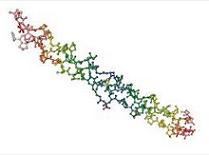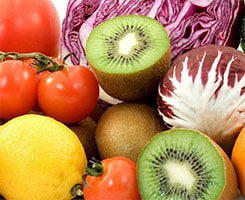 Collagen is a protein found in bones, cartilage and connective tissue. Secreted by certain cells and present in all animals, collagen allows the development of fibers .
Collagen is a protein found in bones, cartilage and connective tissue. Secreted by certain cells and present in all animals, collagen allows the development of fibers .
The process of collagen formation begins when, inside the cells , several series of amino acids join together to form polypeptide chains , which in turn are linked by intramolecular hydrogen bonds. These chains are made up of glycine , lysine , proline and other substances. Various phases of assembly and synthesis finally allow the creation of collagen.
When collagen synthesis is defective, various health disorders can occur, such as Ullrich congenital muscular dystrophy and osteogenesis imperfecta . It is important to highlight that the structures formed with collagen fibers allow them to resist traction forces.
Given the functions that collagen performs in our body , some informally call it “the glue of our body.” But it is a protein that does much more than provide resistance to tissues, since it also helps make them more elastic, filter certain substances and hold all its parts together.
As mentioned in the first paragraph, collagen is a protein that animal organisms can synthesize; We must add, however, that this occurs exclusively in this kingdom, since plants cannot do it. On the other hand, the consumption of certain vegetables and substances of natural origin can stimulate their production , something that millions of people do every day in search of a more youthful appearance.
 Precisely, a diet in which certain components are abundant can promote the production of collagen by our body, and in this group we find the following:
Precisely, a diet in which certain components are abundant can promote the production of collagen by our body, and in this group we find the following:
* foods high in vitamin C, such as lemon, orange, pineapple, grapefruit, mango, melon and kiwi, as well as certain vegetables such as cabbage and Brussels sprouts;
* vegetables such as collard greens, cabbage, endive, kale, spinach, eggplant and cauliflower;
* foods with amino acids , rich in proline and lysine, two substances found in oily fish, lean meats, egg whites and milk;
* red fruits, since their lycopene content has an antioxidant action and collaborates with the generation of collagen. This group includes tomatoes, beets, peppers, strawberries, raspberries, cherries and watermelon;
* nuts, which have many benefits apart from this one. It is recommended to eat pine nuts, walnuts, hazelnuts, chestnuts, cashews, pumpkin seeds, pistachios, almonds and sunflower seeds;
* vegetable oil from seeds (either soybean or sunflower), green leafy vegetables, seafood and oily fish, among other foods with polyunsaturated fatty acids;
* foods that contain genistein, another substance capable of stimulating collagen production. Soy drink is one of the most outstanding examples of this group.
There are different types of collagen according to their molecular composition: from type I collagen to type XXI collagen . The presence of these collagens is distributed throughout different areas of the body.
It should be noted that gelatin is made with collagen. This product with a semi-solid consistency at room temperature is produced with collagen obtained from connective tissue. Collagen is boiled in water and then, when cooled, acquires the typical consistency of gelatin.
Due to its high protein value, gelatin is a food that is recommended in many diets . Dessert gelatin , flavored and flavored with fruits, is popular in many countries.
